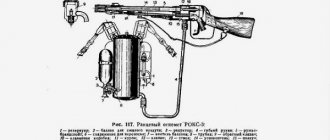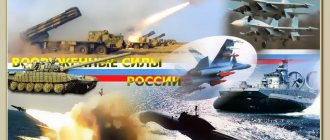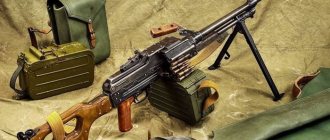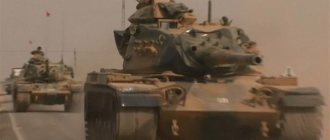Introduction
Fundamental changes in the world have led to the revision of military-strategic concepts, plans for building armed forces and their technical equipment by leading Western countries and the NATO bloc as a whole.
In this regard, the military-political leadership of the North Atlantic Alliance has taken a course towards reducing the number of armed forces. Simultaneously with the reduction, the issue of increasing their combat effectiveness is being resolved by improving the quality of weapons, improving the organizational structure and tactics of combat operations of units, units and formations. Thus, the military-political leadership of the bloc continues to implement the policy of creating smaller, but more professionally trained and better equipped armed forces.
That is why the orders and directives of the Minister of Defense and the Commander-in-Chief of the Ground Forces of the RF Armed Forces emphasize the need for all military personnel to deeply study the organizational structure, weapons, military equipment and combat tactics of units and subunits of the armies of the main NATO countries.
Among the many armies of foreign countries, the most numerous and prepared for combat operations are the armies of the United States and Germany, which are covered in the training manual.
MILITARY UNIFORMS OF BRITISH SOLDIERS
The persistent British in creating military uniforms did not change their conservative inclinations and love of minimalism. The British form rightfully competes with American developments.
British uniforms are great for helping soldiers camouflage. Great Britain updated the colors of its camouflage 13 years ago and still adheres to this pattern.
Now this color is most popular among hunters in mixed terrain. If not for the war in Iraq, it is unlikely that the British would have changed anything in their impeccable uniform.
US Armed Forces
General information
The US Armed Forces include independent branches of the armed forces - the Ground Forces (ground forces), the air force (air force), the naval forces (navy), the marine corps and the coast guard, as well as units and formations of the reserve, including the national guard.
US Army (U.S. Army) June 14, 1775);
United States Air Force (founded September 18, 1947);
United States Navy (founded October 13, 1775);
United States Marine Corps (founded November 10, 1775);
United States Coast Guard (established August 4, 1790).
The first four types of armed forces are subordinate to the Ministry of Defense. The Coast Guard is under the Department of Homeland Security in peacetime and under the Department of Defense in wartime.
The armed forces consist of regular and reserve components.
Reserve components include reserves of all five branches of the armed forces, as well as the Army and Air National Guard. The US National Guard, whose military personnel combine combat training with work in their main specialty, is a so-called organized reserve, and an unorganized (individual) reserve consists of persons with sufficient military training who have relatively recently completed military service and do not need additional preparation.
The number of regular armed forces in 2022 is about 1.4 million people. military personnel and 680 thousand people. civilian personnel. The number of reserve components is about 1.1 million people. Reserve components are continuously assigned to active duty. The number of called up reservists is announced weekly by the Ministry of Defense; their number is about 136,000 people.
The Department of Defense also periodically releases data on the total number of active-duty military personnel. As of 2022, this number was 1,462,000 people, including in the Army - 553,044 people, in the Air Force - 308,300 people, in the Navy - 322,400 people, in the Marine Corps - 182,000 people, in the Coast Guard - 42,000 people. The United States has the largest navy, consisting of 12 aircraft carriers, 27 cruisers, 50 destroyers, 56 submarines and other warships.
In the coming years, the US military department will concentrate its resources in five main areas
:
– the fight against terrorism (that is, the fight against terrorist military forces) and the proliferation of weapons of mass destruction;
- intelligence service;
– preparation for information warfare (protection of US information systems and communications and, accordingly, destruction of similar enemy systems);
– the struggle for military superiority in the air (a special emphasis is placed on the development of unmanned aerial vehicles);
– development of military space systems.
It is emphasized that the main task of the US armed forces should be preparation for war against non-traditional opponents.
December 18, 2022 D. Trump at the International Trade Center (ITC) named after. R. Reagan officially presented his first National Security Strategy (NSS), which reflects the intention to govern the state under the slogan “America First.”
The NSC identifies 4 main areas of national interests of the United States that should enhance US competitiveness on the world stage: ensuring security; ensuring prosperity; maintaining world peace through military, cyber and space power; expansion of American influence on the planet. Among the threats to the United States are outcasts, revisionists and terrorists.
The rogue states “threaten their neighbors with weapons of mass destruction and destabilize important regions.” Revisionist countries "want to create a world that is not consistent with American interests and values." It is in this category that Russia and China are included, given that the United States previously tried to build “loyal partnerships” with them.
According to the NSS, Iran and North Korea are rogue regimes that threaten their neighbors, spread terror, and desire WMD. This in turn destabilizes the regions. The last group includes transnational terrorist organizations and crime syndicates. Active opposition to these forces on the world stage is envisaged. D. Trump even said that the United States defeated the “Islamic State” (IS, banned in Russia) in Iraq and Syria, and the US Armed Forces will pursue terrorists until they are completely destroyed.
Uninterrupted Omnipresence
- new US military doctrine.
Operational omnipresence
is a permanent network presence that allows you to perform any operations, receive and transmit information anywhere in the world. It consists of three main interrelated components: physical assets, virtual capabilities and the information itself. Thanks to it, any object in real time can receive any information about the place, time, events occurring around it, receive and issue control commands. Operational omnipresence is the forward presence of the United States at all times and everywhere.
The implementation of this doctrine is extremely difficult and is only accessible to states that have a competitive advantage in all technological areas. It is provided by three main components of presence - physical, virtual and perceived.
Physical presence
is the strategic positioning of military forces around the world so that they are always in relative proximity to hot spots. In addition to the ships and aircraft currently deployed overseas, the United States maintains more than 150,000 military personnel at 800 bases in 70 countries and counting. The US has 95% of all military bases in the world. Combined with unmanned and autonomous vehicles and aircraft, physical presence remains a core US strength.
Virtual presence
will help eliminate existing shortcomings and gaps in physical presence. Previous concepts defined virtual presence as nearby physical presence coupled with passive presence through advanced technologies. Today, virtual presence allows the use of force from any distance, within hours to nanoseconds, and to be carried out as part of cyber-electronic and space operations. Delivering a strike in cyberspace is absolutely independent of the location of the aggressor and allows, in real time, through the exchange of digital capabilities, to adjust the actions of allies and force changes in the decisions of opponents. In this regard, virtual presence is almost a true form of direct presence.
Perceived presence
is the third part of the concept of operational omnipresence. Perceived presence is the use of technology to collect information and monitor events occurring in places where physical and virtual presence is not possible. It does not include the possibility of using force, but it influences the behavior of the observed and his perception of events.
The White House intends to strengthen and deepen cooperation with European allies and partners, including NATO, in every possible way, in order to counter with a united front the subversive activities and aggressiveness of Russia, as well as threats from the DPRK and Iran. The United States is fulfilling its military commitments to Europe and hopes that NATO member countries will increase their defense spending to 2% of GDP by 2024. Moreover, 20% of this amount will be spent on increasing defense capability. Previously, the Pentagon adopted the US military budget for the 2018 fiscal year, which amounted to $700 billion. Of these, $5 billion will be spent on containing Russia.
In absolute terms, the US military budget is the largest in the world. According to the Stockholm Peace Research Institute, in 2018, the United States accounted for approximately 37.0% of the total military expenditures of the world's states. However, due to events in recent years, especially in the Middle East, plans to reduce funding are questionable. There will be no reduction in spending on the development of the submarine fleet, the creation of a new stealth bomber, the strengthening of the national missile defense system and the expansion of the space satellite constellation. Expenditures will be increased on the development of tracking systems, unmanned vehicles, and means of cyber warfare.
Recruitment of the armed forces is carried out on a voluntary basis. Citizens of the United States and citizens of other states permanently residing in the United States with at least a secondary education are accepted for service.
The minimum age of the candidate is 18 years (17 years with parental consent). The maximum age for enlistment depends on the branch of the armed forces and membership in the regular forces or reserve components (Regular Air Force, Regular Coast Guard - 27 years, Regular Marines, Marine Corps Reserve - 28 years, Air Force Reserve, Air National Guard, Regular Navy - 34 years, Army Reserve, Navy Reserve, Coast Guard Reserve - 39 years, Regular Army, Army National Guard - 42 years). The contract period is from 2 to 8 years.
All military personnel (both Regular Forces and Reserve Components) begin their service by attending a basic combat training course in special camps (9 weeks in the Army, 6 weeks in the Air Force, 8 weeks in the Navy and Coast Guard, 12 weeks in the Marine Corps). After this, regular military personnel undergo special training, the duration of which depends on the military specialty being mastered, and are sent for further service in the troops.
Military personnel of the reserve components, after the initial combat training course, are involved in training one weekend a month and two weeks a year. If necessary, military personnel of reserve components are called up for active service.
At the beginning of 2022, the racial and ethnic composition of the American armed forces looked like this: white Americans - 63%, African Americans - 15%, Hispanics - 10%, others - 6.0%. Almost 4% of American military personnel were foreign citizens with the right to permanent residence in the United States (“green card”). The majority are Latinos. They are attracted by the opportunity to quickly obtain American citizenship.
According to the views of the US military-political leadership, due to the ongoing changes in structure and equipment, in the future the use of new information technologies by the ground forces will have a significant impact on the development of forms and methods of warfare. Improving the information support of the US Army in the theater of operations will allow commanders of formations at all levels to more clearly imagine the overall picture of combat operations. By increasing the reliability of communications and automation of combat control, elements of which will be located directly in combat formations, the efficiency of command and control of units will increase.
The main directions for improving information support for the US Army in the theater of operations in the period until 2030 include the following:
– the formation of a single global information space in which each combat unit will be provided with access to information about the tactical situation;
– integration of the ground forces intelligence system in the theater of operations into the global information network of the US Armed Forces, ensuring self-synchronization of combat operations based on flexible and “seamless” interaction of all forces, means and bodies involved in a military operation:
– expanding opportunities for real-time information exchange by increasing the capacity of communication lines;
– increasing the level of information security, stability and survivability of the US Army intelligence system in the theater of operations.
A high degree of awareness, formed on the basis of an analysis of the overall picture of combat operations, will allow commanders of formations and units to conduct effective offensive and defensive actions by organizing close interaction of forces and means and quickly respond to any changes in the situation. Commanders of subordinate units and subunits will be able to more fully perceive the emerging situation and act, showing initiative, without waiting for orders from higher command. Due to this, ground forces will be able to create the most favorable conditions for conducting an offensive and avoid an unforeseen collision with the enemy during the advance.
"The most serious consequences"
NATO exercises taking place in close proximity to Russia's borders raise understandable concerns.
When we are indivisible: what will be the Russian proposals for NATO non-expansion
And how the United States is trying to become a mediator between Russia and Ukraine
Press Secretary of the Russian President Dmitry Peskov noted that NATO’s actions look like encouraging Kyiv’s aggressive sentiments. Under the cover of such exercises in the Black Sea, Ukraine is most likely seeking another attempt to begin a forceful solution to its internal problem, he noted.
Earlier, Peskov emphasized that such an escalation of the presence of NATO forces in the region could lead to “the most serious consequences” for Ukraine.
— The exercises that Ukraine is conducting with NATO pose a serious threat, since they are aimed at practicing warfare against Russia. In addition, they can serve as cover for the deployment of a group of troops. Their appearance may result in them not leaving there,” military expert Konstantin Sivkov told Izvestia.
In his opinion, the Russian Federation must “clearly, in addition to diplomatic statements, prepare to repel military aggression.” This requires the creation of troop groups, the development of new weapons systems and the conduct of exercises.
— Such a large number of exercises are carried out for the military development of Ukrainian territory. They are studying the supply of military targets, the location of troops, missile launchers,” said retired Colonel General, former commander of the Russian Airborne Forces Georgy Shpak in a commentary to Izvestia.
It's NATO for them
US Marine with Marine Rotation
Photo: Global Look Press/US Department of Defense
He recalled that the United States considers two states to be its enemies - China and Russia. And Ukraine, in his opinion, is “a bargaining chip in this big war game.”
“Freedom to join unions cannot be absolute”
Deputy Foreign Minister of the Russian Federation Sergei Ryabkov - about why it is dangerous to accept Ukraine into NATO, and the date of the next meeting between Putin and Biden
— America is thoroughly preparing for war with China and Russia. To do this, she needs to bring her troops as close as possible to the borders of Russia. Naturally, the General Staff monitors such American actions very carefully and, studying their tactics and strategy, takes appropriate countermeasures to defend and possibly prevent their offensive operations.
Shpak expressed the opinion that until the Ukrainian leadership changes, the strategic policy of this country towards Russia does not change, one should not expect a positive solution to these problems.
“The President clearly stated that the territory of Ukraine is a “red line” that Americans are not advised to cross. This is very dangerous for Russia. Naturally, both the President of the United States and the leadership of Ukraine were warned about this. But, as we see, there is no special reaction yet. And this is fraught with serious consequences, because both world wars began with small incidents. We must remember this.
Notes[ | ]
- ↑ 12
Combat training of troops // Military Encyclopedia: [in 18 volumes] / ed. V. F. Novitsky ... [and others]. - St. Petersburg. ; [M.]: Type. t-va I. D. Sytin, 1911-1915. - Encyclopedia of the Strategic Missile Forces.
- Platz // Encyclopedic Dictionary of Brockhaus and Efron: in 86 volumes (82 volumes and 4 additional). - St. Petersburg, 1890-1907.
- ??? // KSOTOT, 1958
- Dictionary of military terms. / Comp. A. M. Plekhov, S. G. Shapkin. - M.: Military Publishing House, 1988.
- Great Soviet Encyclopedia: [in 30 volumes] / ch. ed. A. M. Prokhorov. — 3rd ed. - M.: Soviet Encyclopedia, 1969-1978.
- Combined arms training // Soviet military encyclopedia. - Moscow: Military Publishing House of the USSR Ministry of Defense, 1978. - T. 5. - P. 676.
- General military regulations of the Armed Forces of the USSR. VoenIzdat. Moscow. 1979 447 pp.
- Manual on Physical Training in the Soviet Army and Navy (NFP-87) Archived copy dated February 8, 2015 on the Wayback Machine
- Indoctrination in the US Army
- Parachutist training in the US Army
- Analysis and evaluation of foreign experience in training military aviation flight personnel
- A manual on terrain orientation and working with topographic maps
- Baka M. M.
Physical and military-applied training of youth. Chapter 9. Military topography. — Soviet sport. — ISBN 5-85009-944-1. - Fighting navigation systems
- Beat your own so that strangers will be afraid. China shot down its own satellite with a missile
- Strike into space. The destruction of an American satellite could launch a new “Star Wars”
- Rules of the diving service of the Navy PVS VMF-2002. Military Publishing House. Moscow 2003. 290pp.
- Field trip (undefined)
.
Ministry of Defense of the Russian Federation (Ministry of Defense of Russia)
. - Field trip // KSOTOT, 1958
Content
- 1 Organization of combat training
- 2 Types of combat training
- 3 Combined arms training 3.1 Drill training
- 3.2 Study of statutes
- 3.3 Physical training
- 3.4 Tactical training
- 3.5 Fire training
- 3.6 Intelligence preparation
- 3.7 Engineering training of troops
- 3.8 Chemical preparation
- 3.9 Military medical training
- 3.10 Moral and psychological preparation
- 3.11 Foreign armies
- 4.1 Special tactical training 4.1.1 Special engineering training
Combat training
- an organized process of military training aimed at providing troops with the opportunity to make the most effective use of the totality of all information, techniques and skills necessary for the armed forces to perform combat service in wartime[1][2].










